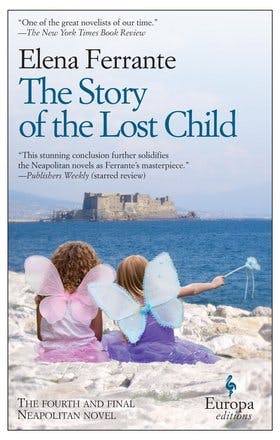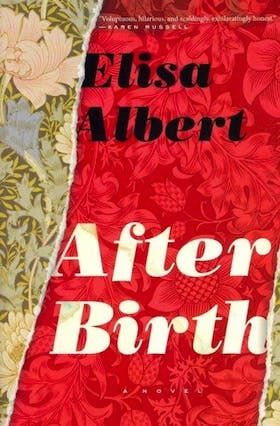In My Brilliant Friend, the first novel in Elena Ferrante’s Neapolitan series, a pubescent Elena Greco worries that she will lose her friend Lila, and finds that “that idea brought on a weary exhaustion.” Soon after, she gets her period for the first time. The juxtaposition—worry, exhaustion, menstruation—is not definitive, but it is suggestive. In culture, the female body is fraught ground: as women, we can be uncomfortable talking about our bodies, in part because when we do, we’re often heard incorrectly, incompletely, or not at all. “I feel like a traitor admitting that PMS lays me flat,” wrote novelist Diana Spechler in May of this year for The New York Times’s Opinionator blog. At Slate, Laura Bennett recently bemoaned the proliferation of confessional essays, in which women wrote intimately about their bodies and bodily functions. The female body remains a thing to be hidden and tamed, rather than listened to or written about.
Ferrante’s attention to the female body has been one of the great pleasures of her Neopolitan series, which concluded with the publication, in September, of The Story of the Lost Child. Chronicling, with thrilling intensity, a life-long friendship between two women, Elena Greco and Lila Cerullo, born in an impoverished Neopolitan neighborhood at midcentury, Ferrante lets the bodies of her female characters not only function but also speak. Elena and Lila bleed; they get pregnant, and gain weight, and nurse babies, and do their hair. And Ferrante’s attention extends past the—traditionally female—domestic or romantic spheres. “All the characters,” Lidija Haas noted in the Times Literary Supplement, “but the women first of all, feel in their bodies … the constant blows of the system in which they live.” Ferrante’s women experience abandonment, injustice, emotion, on their very skin—and this is treated not as weakness, but plainly as fact.

Take, for instance, the stereotype of women as vengeful harridans, furious beyond all reason when scorned. The Story of a New Name, the second in the series, opens at sixteen-year-old Lila’s wedding. When the bride, insulted by an ex-suitor, turns livid, Elena feels not fear or dismay, but a kind of joy: “[Lila’s] rage expanded in my breast, a force that was mine and not mine, filling me with the pleasure of losing myself.” What might, in another author’s hands, read as typically female volatility is here presented as powerful, even logical: “If nothing could save us,” Elena thinks, exhilarated, as her friend tugs insistently on the groom’s arm, in an attempt to spur him to defend her, “not money, not a male body, and not even studying, we might as well destroy everything immediately.” Elena watches as Lila abruptly storms out.
Or, consider the double-bind of contraception. In the third book, Those Who Leave and Those Who Stay, Elena, now a wife and an author with two daughters and one book to her name, decides she does not want another child. Sapped of the ability and will to write by her first two pregnancies, she is determined not to sacrifice body or mind to a third. And yet the solutions at her disposal all also involve, to a certain degree, a loss of control over her own body: condoms prolong her already unpleasant sexual encounters with her husband; oral contraception means putting herself at the mercy of artificial hormones. Elena goes on the pill and promptly gains weight. “I felt as if I’d swelled up,” she reports flatly, “yet I didn’t dare stop.” What’s impressive is not that Elena can bear the insult to her body—but that this insult remains both common, and rarely dramatized. (Meanwhile her husband, who has to be prodded to do so much as one sink of dishes, looks at her pimples and wonders if she’s sick.)
A theme throughout the series, it is in The Story of the Lost Child that Ferrante’s preoccupation with the female body is at its most potent. Elena has struggled, since childhood, to live a life of the mind. Determined to leave the poverty and violence of her Neopolitan neighborhood, she has studied, tried to make her “head masculine, so that it would be accepted by the culture of men.” And in these efforts she has, up to now, succeeded, leaving Naples for a university in Pisa, marrying the son of Northern intellectuals, and publishing a well-received novel. But of course this can’t last—such self-denial never can, and perhaps it shouldn’t. For Elena, in any case, it doesn’t: before The Story of the Lost Child begins, her marriage has failed and her second novel has been rejected.
Abandoning fiction, Elena writes a slim tract, an exploration of “the invention of women by men,” of the way in which the logic of the masculine head unjustly dominates the sensations of the female body. Abandoning her husband, to whom she has never been attracted, she begins a torrid affair with a man from her hometown, Nino Sarratore. Over the course of three books, Elena has fought her body—and, by extension, her crude, vulgar roots. Now, in The Story of the Lost Child, Elena, for the first time, allows her wild, desiring flesh free rein.
Elena learns to listen to her female body and its impulses in Italy in the 1970s, but in the last few years these themes have reemerged as important preoccupations in literary circles. Maggie Nelson’s memoir The Argonauts for instance, published last year, mixes visceral descriptions of her pregnancy and childbirth with quotations from Gilles Deleuze, Judith Butler, and William James, among others, placing theory and the physical experience of motherhood on the same plane. In one scene, Nelson recalls attending a seminar in 1998, where feminist theorist Jane Gallop presents new work, and art critic Rosalind Krauss is slated to respond. Gallop’s work turns out to center on photographs taken of her and her young son; Krauss’s reaction is tart. “The tacit undercurrent of her argument, as I felt it,” writes Nelson, “was that Gallop’s maternity had rotted her mind … Krauss acted as though Gallop should be ashamed for trotting out naked pictures of herself and her son in the bathtub.” It is an argument that Nelson’s whole book—she includes a graphic description of the birth of her own son—pushes back against.


Ariella, Elisa Albert’s protagonist in After Birth, reacts to a similarly dismissive attitude towards maternity with a snappy one-liner. Ari is a new mother, and the experience has made her more aware of the physical differences between women and men. At a Christmas Eve dinner, she alarms, and delights in alarming, other guests—one “dead-eyed” woman in particular—by breast-feeding her one-year-old son. “I will not,” Ari fumes silently, “go sit in the toilet in the middle of my dinner so you don’t have to trouble yourself about the fact that you’re a bipedal mammal, bitch.”
But if Ferrante, too, embraces what is viscerally feminine, she also encounters problems with it. Her enthusiastic narration of the experience of having a female body is above all factual. She remains clear-eyed. Obeying one’s womanly urges does not, in Ferrante’s world as in the world outside her fiction, necessarily lead to freedom, and Elena remains trapped within the ceaseless flow of events that characterize both the passage of time and this quartet of novels. The illness and eventual death of Elena’s mother; an earthquake that devastates Naples; her sister’s relationship with a local gangster; her eldest daughter’s rebellion—these are facts that Elena must in any case face, whether with a masculine mind, or with a feminine body.
Even Elena’s most impulsive decision—the one spurred most specifically by the desires of her female body—does not, in the end, bring satisfaction. Elena wants to believe that she is loosing a bond and escaping male domination when she leaves her husband for Nino. But perhaps she swaps one type of constraint for another. After all, being with Nino means returning to Naples, to the brutal, ignorant world she has so recently escaped. And it means, as she discovers months into the affair, accepting that Nino will never leave his wife, that he will even continue sleeping with her. “Was I lying to myself,” Elena wonders, “when I portrayed myself as free and autonomous?” In turning away from the masculine mind, has she made herself a slave to the feminine body?
Ferrante does not answer this question. Nino is able to indulge the desires of his body while knowing he will never face severe consequences. But for Elena, questions about the body—what to do with it, whether to listen to it—hang over the rest of the novel.
In Those Who Leave and Those Who Stay, Elena, working on her second book, worries over the word “become”: “It was a verb that had always obsessed me, but I realized it for the first time … I wanted to become, even though I had never known what.” In The Story of the Lost Child, Elena finishes the process of becoming and becomes. Now a successful writer in late middle-age, she lives alone, with a dog, unattached. She is old more than she is male or female. The reward for surviving your life—or perhaps the punishment or perhaps just the result—the Neopolitan novels seem to imply, is to end up in a body whose signals might at last be clear. Memories remain, but they are no longer freighted with desperate joy, or desperate sorrow. In place of wild desires, the throb of hormones, the stab of abandonment, there is hunger, and weight, and perhaps the ache of arthritis. And is that not a kind of relief?
